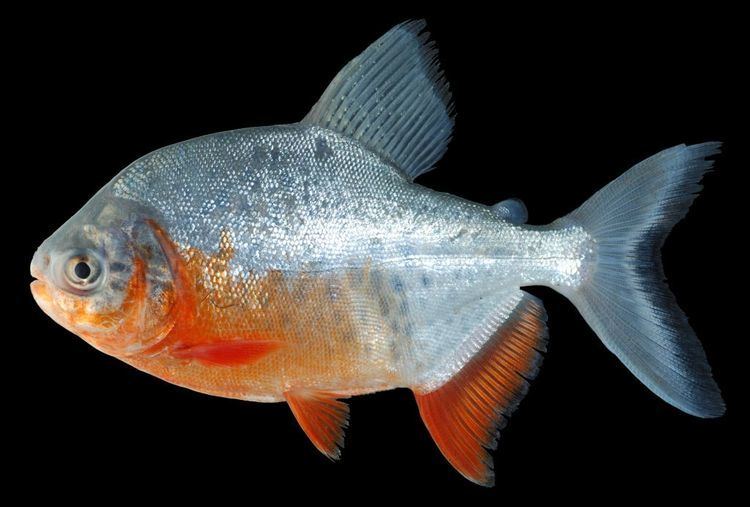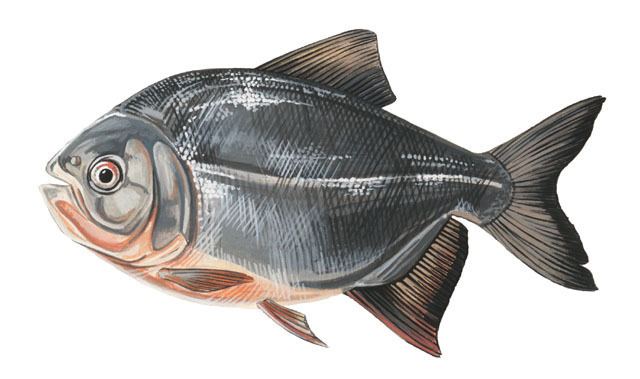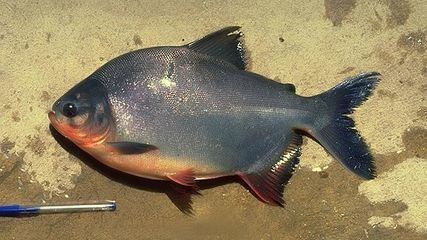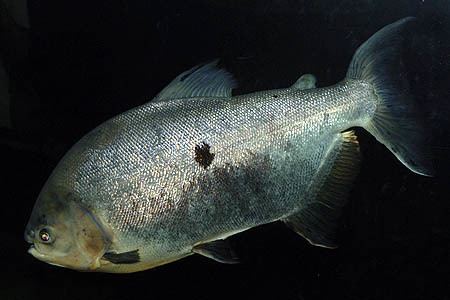Higher classification Piaractus | Phylum Chordata Scientific name Piaractus brachypomus Rank Species | |
 | ||
Similar Piaractus, Colossoma, Tambaqui, Piaractus mesopotamicus, Serrasalmidae | ||
Colossoma brachypomus piaractus brachypomus red bellied pacu
Piaractus brachypomus, the pirapitinga, is a large species of pacu, a close relative of piranhas and silver dollars, in the serrasalmid family. It is native to the Amazon and Orinoco basins in tropical South America, but it is widely farmed and has been introduced to other regions.
Contents
- Colossoma brachypomus piaractus brachypomus red bellied pacu
- Ecology
- Appearance
- Connection to humans
- In aquariums
- Captive diet
- References

As with a number of other closely related species, P. brachypomus is often referred to as the red-bellied pacu in reference to the appearance of the juveniles. This has resulted in a great deal of confusion about the nature and needs of all the species involved, with the reputation and requirements of one frequently being wrongly attributed to the others.
Colossoma brachypomus piaractus brachypomus red bellied pacu
Ecology

In general, the behavior resembles that of the closely related tambaqui (Colossoma macropomum). The pirapitinga is migratory, but the pattern is poorly understood. Spawning occurs at the beginning of the flood season between November and February. Larvae of the pirapitinga are found in whitewater rivers, but adults mainly live in flooded forests and floodplains of variours river types, including both nutrient-rich and nutrient-poor. Unlike the tambaqui, the pirapitinga also occurs in the headwaters of nutrient-poor rivers (not just in the lower sections).

It mainly feeds on fruits, seeds and nuts, but it is opportunistic and will also take zooplankton, insects, crustaceans and small fish, especially in the dry season. In general, more seeds are able to pass undamaged through the pirapitinga than the tambaqui, meaning that the former overall is a more effecient seed disperser.
Appearance
P. brachypomus can reach up to 88 cm (2.9 ft) in length and 25 kg (55 lb) in weight.
Juveniles have a distinct red chest and belly, and are easily confused with the carnivorous red-bellied piranha (Pygocentrus nattereri), but the two can be separated by their teeth, which are molar-like in Piaractus. This similarity is believed to be mimicry by P. brachypomus in an attempt of avoiding predation by other species. Adults lack the bright red chest and belly, and resemble the tambaqui (Colossoma macropomum), but can be separated by several meristic and morphological features: The pirapiting has a smaller adipose fin that lacks rays, as well as differences in teeth and operculum. The pirapiting also has a more rounded head profile (less elongated and pointed). The other member of its genus, P. mesopotamicus, can be distinguished by its smaller scale-size and the higher number of lateral scales (more than 110).
Connection to humans
The pirapitinga supports major fisheries and based on a review by IBAMA, it was the 12th most caught fish by weight in the Brazilian Amazon in 1998 (just after of the tambaqui).
The pirapitinga is often kept in aquaculture. Hybrids between this species and the tambaqui have been produced in aquaculture.
In aquariums
Juvenile pirapitinga 5–7.5 cm (2–3 in) long, sometimes labelled as "vegetarian piranha" or "red-bellied pacu", are frequently seen in the aquarium trade, but they rapidly grow to a large size and require an enormous tank.
It reaches a very large size, but is smaller than its well-known relative Colossoma macropomum. It can and will grow quickly under favourable conditions. The overall size to which it can grow remains a matter of considerable debate and no small amount of confusion. Much of the confusion stems from the fact that one species can and often is easily mistaken for another, and the size attainable in captivity is usually less than the size attainable in the wild. However, it can easily outgrow the majority of home aquaria: they are strong and robust fish which need a lot of swimming space and make very heavy demands of the filtration system.
At larger sizes, the P. brachypomus needs a correspondingly large tank to thrive in captivity. The temperature of the water in which they are kept should be within 78–82 °F (26–28 °C) and the system should be well filtered and oxygenated. Larger P. brachypomus are sometimes classed as "monster fish" and find a place in aquariums which house other large fish. They tend to be timid and retiring and will retreat to cover if they feel insecure. Some squabbling may become apparent if they are kept in a group.It can take a lot of time for them to get accustomed to the aquarium, and may try to jump out frequently.
Captive diet
In the aquarium offer it a varied diet consisting of quality dried pellets or floating sticks, along with plenty of fruit and vegetables. Spinach, lettuce leaves, and fruit and vegetables such as apple, banana, peach, grapes, courgette, peas, cabbage and carrot all work well. They will also sometimes "snatch" floating food, which results in a lot of splashing and makes a lid essential. In captivity, it is inadvisable to keep this species with anything small enough to be regarded as food, though they are usually safe around larger fish.
